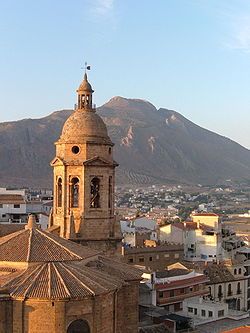Loja, Granada
Loja | |
|---|---|
 Bell Tower of the Church of the Incarnation. | |
| Nickname: Flower among thorns[1] | |
| Coordinates: 37°10′N 04°9′W / 37.167°N 4.150°W | |
| Country | |
| Autonomous community | |
| Province | Granada |
| Comarca | Loja |
| Judicial district | Loja |
| Founded | 9th century BC |
| Government | |
| • Mayor | Francisco Joaquín Camacho Borrego (2011) (PP) |
| Area | |
• Total | 454.7 km2 (175.6 sq mi) |
| Elevation | 448 m (1,470 ft) |
| Population (2018)[2] | |
• Total | 20,371 |
| • Density | 45/km2 (120/sq mi) |
| Demonym | Lojeños |
| Time zone | UTC+1 (CET) |
| • Summer (DST) | UTC+2 (CEST) |
| Postal code | 18300 |
| Website | www |
Loja (Spanish pronunciation: [ˈloxa]), formerly Loxa,[3] is a town in southern Spain, situated at the western limit of the province of Granada. It is in the valley of the River Genil,[3] overlooked by the so-called Sierra de Loja, of which the highest peak, Sierra Gorda, stands 1,671 metres above sea-level.
History
[edit]Loja has sometimes been identified with the ancient Ilipula, or with the Lacibi (Lacibis) of Pliny and Ptolemy.[3] It is unknown when Loja was first captured by the Moors; most likely this happened in the 8th century. It first clearly emerges in the Arab chronicles of the year 890.[3]
Reconquista
[edit]It was taken by Ferdinand III of Castile in 1226, but was soon afterwards abandoned.[3]
As part of the Granada War, Loja was attacked in 1486 by Christian forces under Ferdinand and Isabella. These soldiers included some Englishmen commanded by Sir Edward Woodville.[4][5] The victorious Spanish allowed the Muslim population to leave for Granada. The town's Moorish name, Medina Lawša, was changed to Lauxa. Isabella called it the "flower among thorns".[1] In 1491 work began on the Church of the Incarnation on the site of the town's main mosque.

19th century
[edit]The town was the centre of the Loja uprising in 1861, led by local Rafael Pérez del Álamo, that was quickly suppressed.
In the 1870s a railway train arrived in the area linking Bobadilla and Granada.
Main sights
[edit]The town's Islamic heritage is still evident in the quarter of the Alcazaba, a Moorish fortress of which most of the walls and towers remain.
Other sights include:
- Convent of Santa Clara (16th century)
- Convento of St. Francis of Assisi, including a 16th-century cloister
- Church of the Incarnation, the main church which was begun in Mudéjar style at the end of the 15th century
- Church of San Gabriel (16th century)
- Church of Santa Catalina (16th-17th century)
- Church of N.tra S.ra Virgen de la Caridad (16th century)
- Hermitages of Jesus Nazareno, san Roque, and Calvario, 16th century chapels and sanctuaries
- Caseron de los Alcaides Cristianos (17th century)
- Palacio de Narvaez (17th century)
- Fuente de la Mora ("Fountain of the Moorish maiden"), also known as los venticinco canos, a fountain where waters from different springs are made to flow from twenty-five tubes.
Notes
[edit]- ^ a b "Loja".
- ^ Municipal Register of Spain 2018. National Statistics Institute.
- ^ a b c d e Chisholm, Hugh, ed. (1911). . Encyclopædia Britannica (11th ed.). Cambridge University Press.
- ^ Delgado (2021). "Un guiri inglés en la Toma de Loja" (in Spanish).
- ^ Lawrence DR. Christopher Wilkins. The Last Knight Errant: Sir Edward Woodville and the Age of Chivalry. London: I. B. Tauris & Co. Ltd., 2010. xxii 234 pp. index. append. illus. bibl. £25. ISBN 978-1-84885-149-8. Renaissance Quarterly. 2010;63(2):631-633. doi:10.1086/655286
References
[edit]- Days in the Sun by Martin Andersen Nexo (1929)






